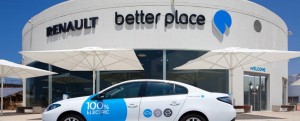It’s the cleantech failure that makes Solyndra look small. When the electric vehicle startup Better Place collapsed into bankruptcy this week, it forced investors, entrepreneurs and policymakers around the world to pause for a moment of silent contemplation.
The main question on everyone’s mind: What went so disastrously wrong? Better Place enjoyed an uncommon array of advantages, including $850 million in backing, plus support from major Israeli political and industry leaders who saw in electric cars a way to reduce their dependence on their oil-rich neighbors. Now the company finds itself with just $9.5 million in assets, facing immediate liquidation.
So was it a colossal failure of leadership? Did the flaw lie in the company’s ambitious strategy of replacing gas stations with its own network of battery swapping stations, which founder and former celebrity CEO Shai Agassi predicted would lead to electric cars taking over more than half of the Israeli market by 2016? Or does the problem go even deeper, suggesting that electric vehicles are simply not ready for the marketplace?
As usual, the take on such a big company racing off a cliff depends in large measure to how close the observer is standing to the same cliff. Closest to the precipice may be Tesla Motors, which came off a disastrous test drive of its Model S sedan by New York Times writer John Broder to announce its first quarterly profit in Q1 2013, repaid its $465-million federal loan nine years early, announced plans to raise in the neighborhood of $1 billion in new funding, and just this week unveiled plans to triple the number of quick recharging stations around the country to help mitigate “range anxiety”, a key challenge to electric vehicle adoption.
Still, Tesla’s profit margin was minimal, at $11 million on total revenue of $582 million, and it came not from selling cars but rather from the sale of pollution credits, as the Christian Science Monitor reported.
With such a narrow toehold of success, Tesla and its supporters were quick to make the argument that the problem at Better Place was not with electric vehicles, but rather with the boring, oversized electrical vehicle supplied by Renault.
“(It) HAS to be better than the BEST vehicles available (looks, performance, amenities, options, etc.),” one supporter wrote on Tesla’s blog. “Again, proof why Tesla is succeeding while others are failing.”
The agreement with Renault evidenced an even greater failure than that, writes John Gartner, associate director of the energy practice at Navigant, a consulting firm. The entire point of battery swapping is to make the technology compatible with a wide variety of attractive cars, and “once it was clear that only Renault would be a partner, the implosion clock started ticking,” Gartner says.

Some observers focused on bloat at Better Place, noting that the company’s giant infusion of cash fueled a large bureaucracy that was insufficiently utilized to tackle its huge challenges of commercializing a brand-new business model. Meanwhile, Agassi was so busy globetrotting, attending fancy conferences and trying to make other deals happen, that he lost focus on the company itself, Jacob Ner David, an Israeli entrepreneur, told the Wall Street Journal.
“Over the last few years I’ve spent hours chatting with many very bright and committed people at Better Place who were underutilized and mismanaged,” wrote Gartner.
Other analysts focused on Better Place’s failure to nail basic business fundamentals. Forbes magazine, which once described Better Place CEO Shai Agassi as a wunderkind, pointed out that Better Place stuck potential customers with a risky proposition, paying a premium for a car with uncertain resale value and scarce battery replacement stations. The company tried to spread too far too fast, originally targeting the U.S., Australia, Israel and Denmark, the exact opposite of Autolib, which is focusing its electric vehicles to just a few trendy neighborhoods in Paris. Gartner agrees, saying that a useful target could have been taxi or delivery fleets.
“Better Place had difficulty defining what foothold it was pursuing,” wrote Forbes contributor Stephen Wunker.
Few analysts or investors seemed to believe that the failure of Better Place has any implications for the wider electric vehicle market, in which many different companies are trying such a broad array of battery technologies and business models that it makes any global predictions difficult to pin down. Seoul, South Korea certainly appears undeterred, as the city government unveiled its own “Electric Vehicle Sharing” program last week in which drivers can rent a micro Kia SUV for $5 an hour. About 15,000 people signed up for the program within its first three weeks.
For its part, Renault tried to get ahead of such speculation. Describing the hundreds of millions of dollars spent on Better Place as a “very small part” of the $5.17 billion that the automaker has committed to spending on electric vehicles by 2015, Gilles Normand, chairman of Renault’s Asia-Pacific operations, made clear that “In no way does this put in question our strategy concerning electric vehicles.”